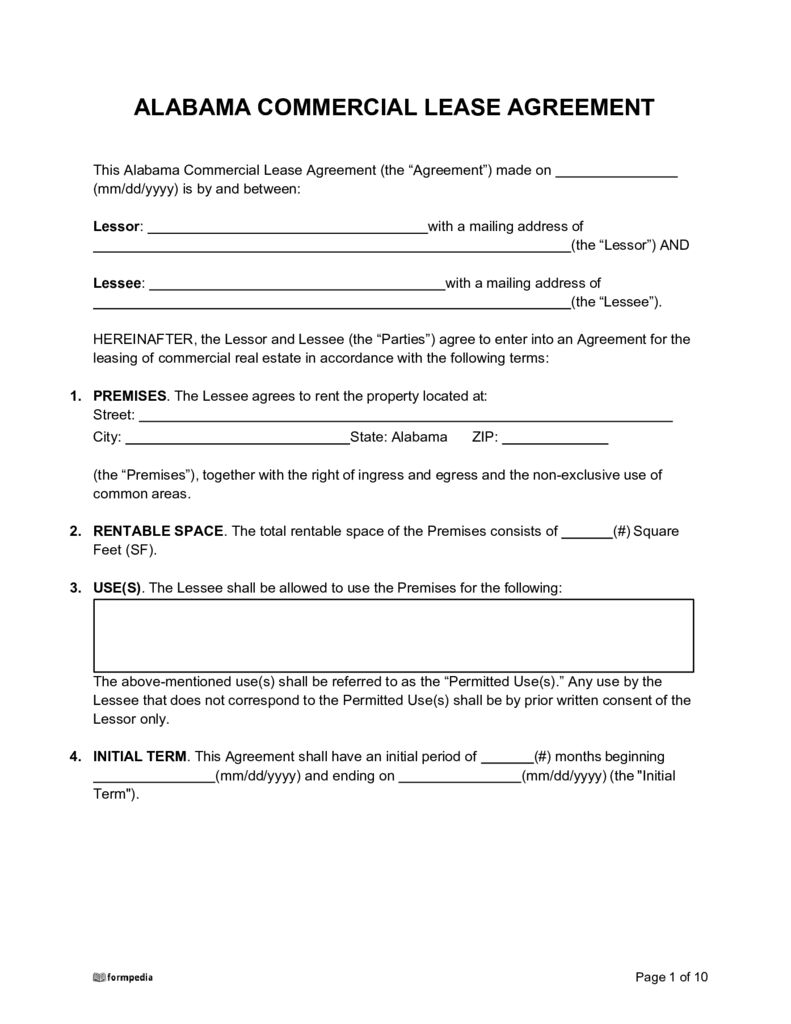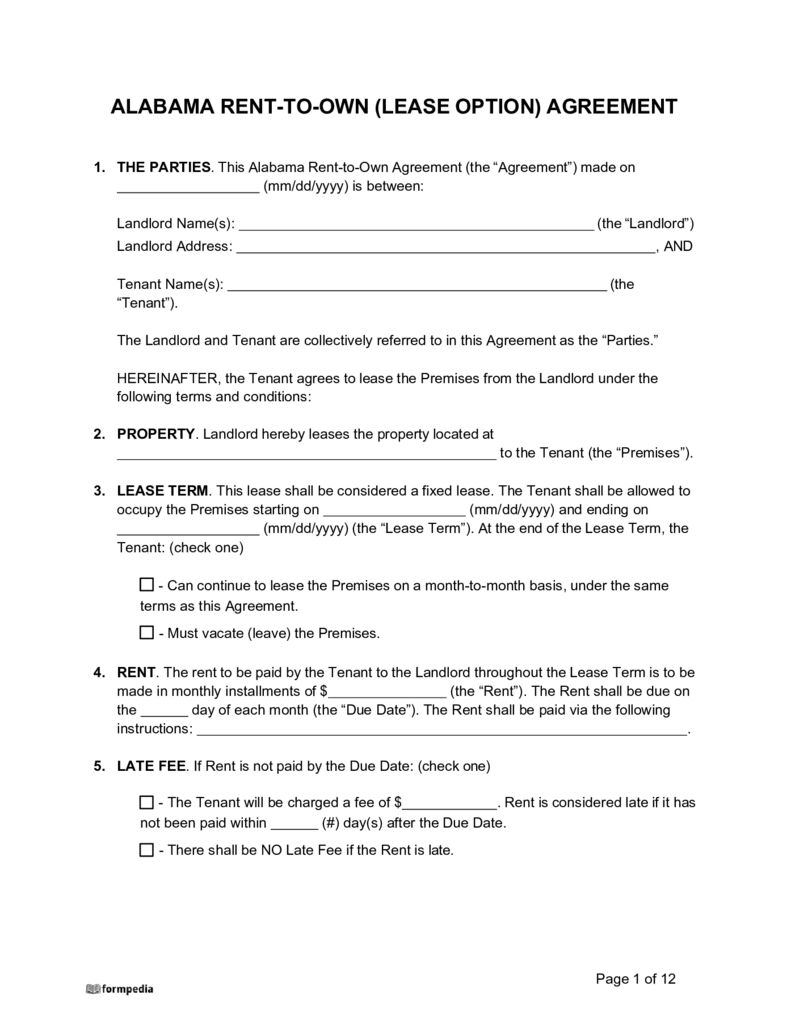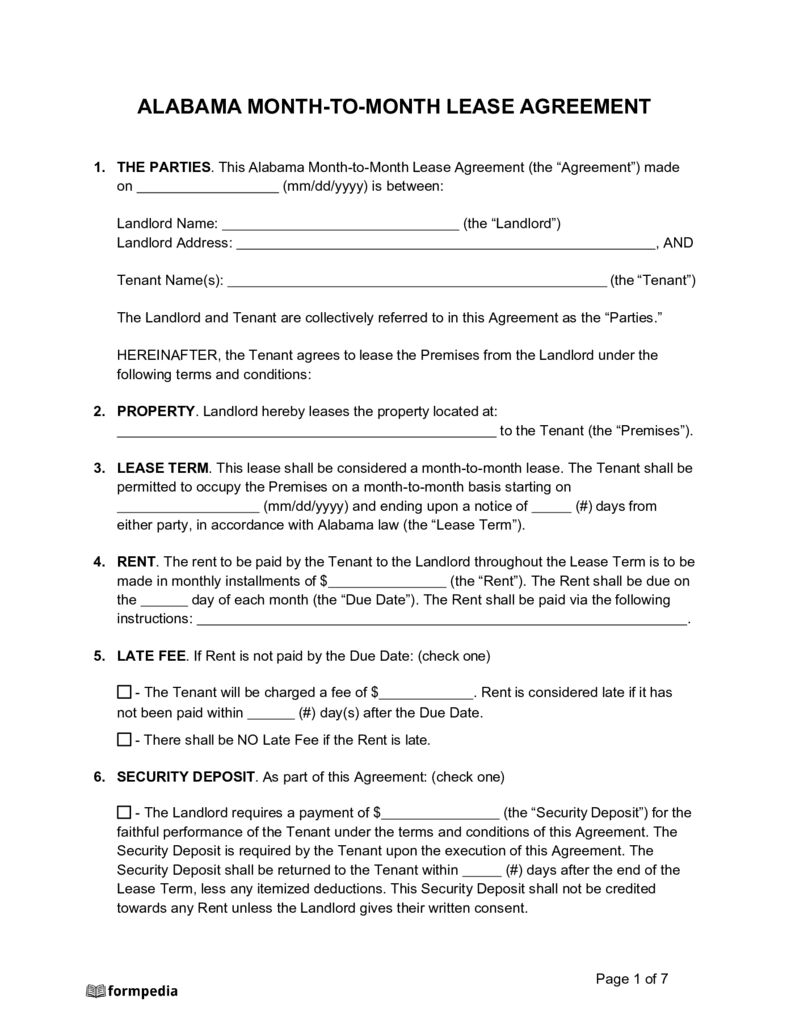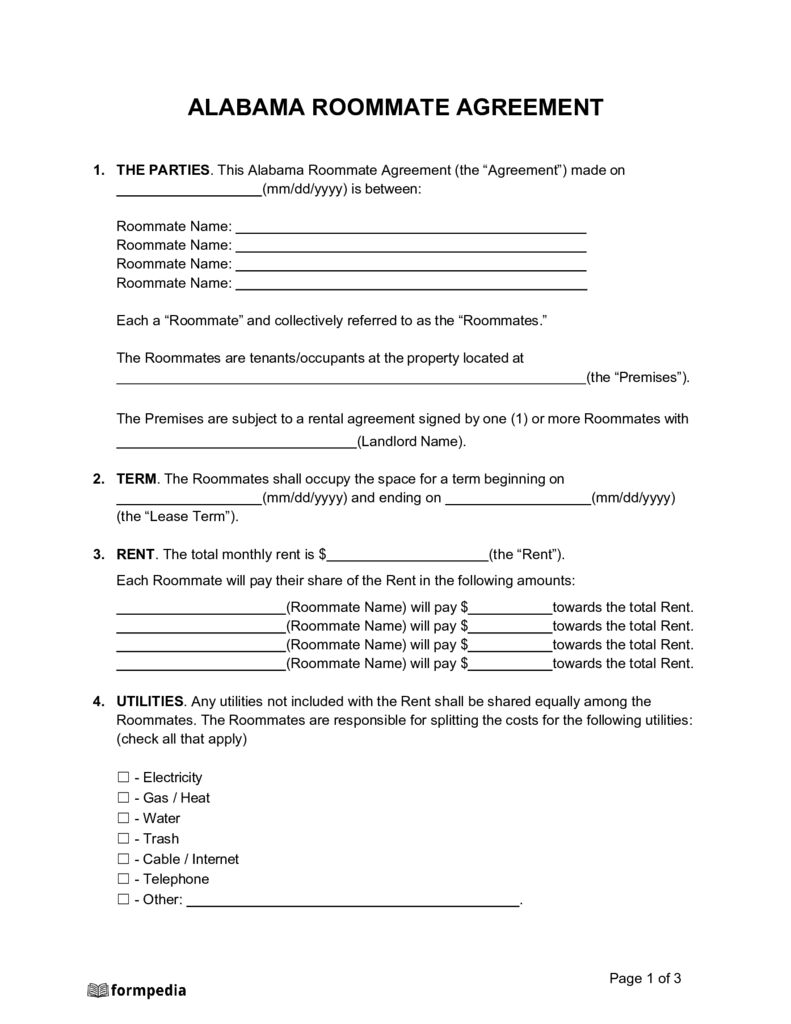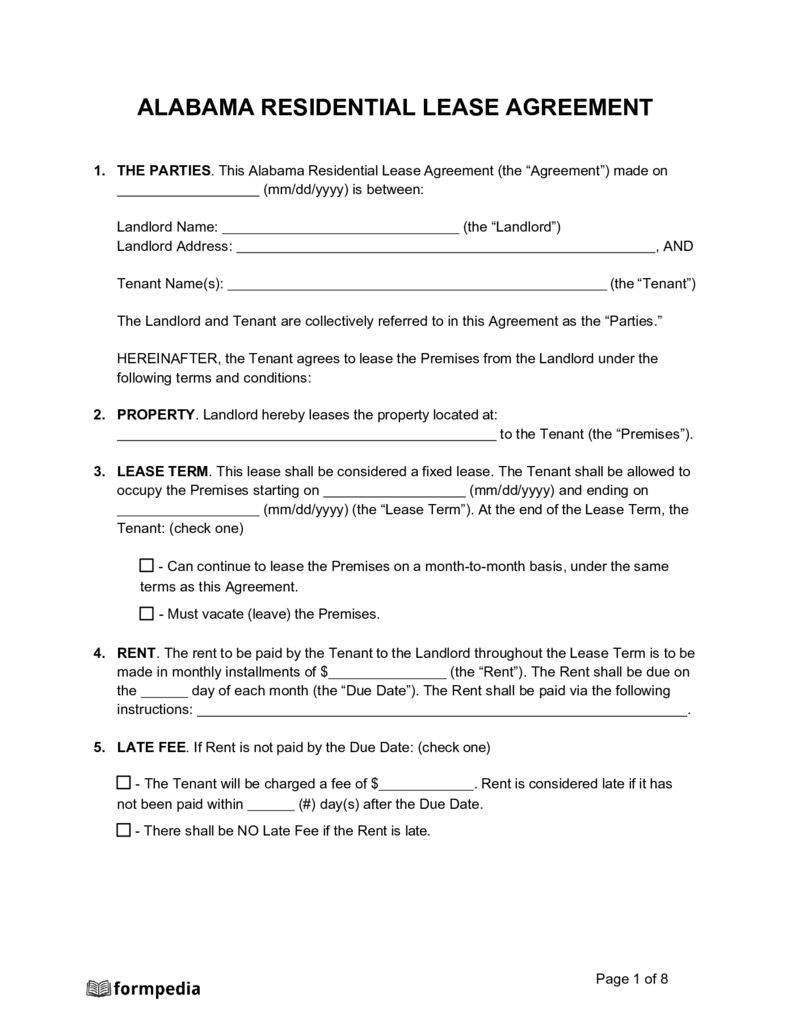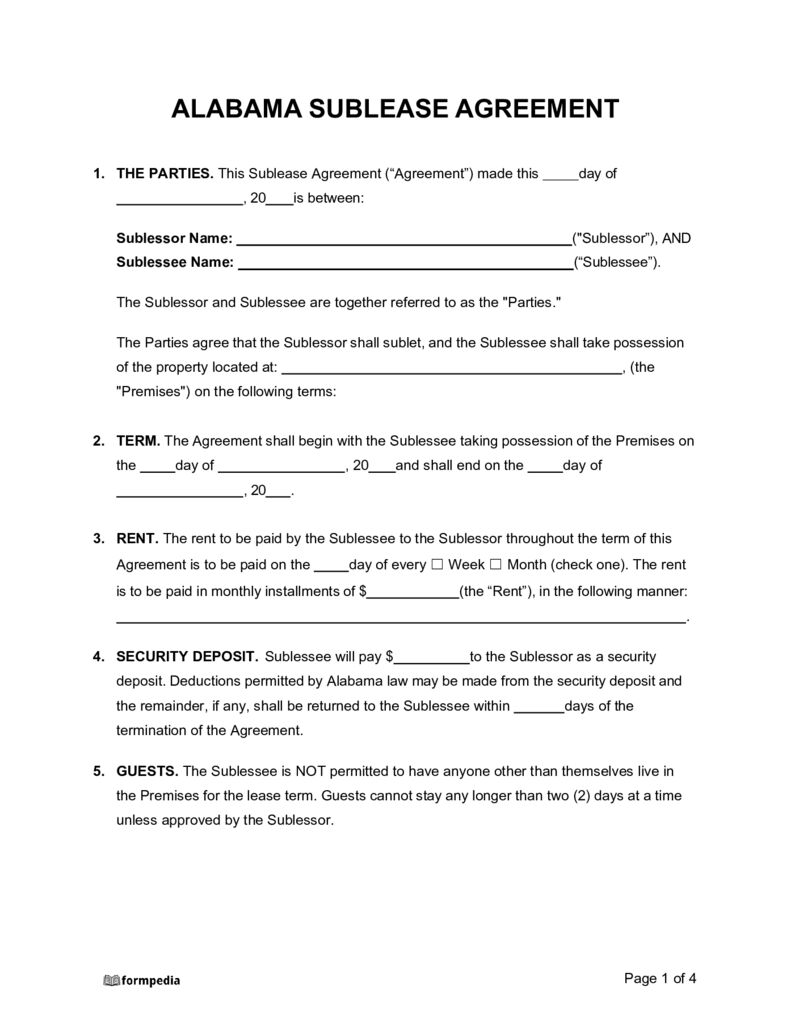An Alabama rental lease agreement is a legally binding contract between a landlord and tenant that outlines the terms and conditions of the property rental. It includes specifics such as the amount of rent, security deposit, maintenance and repair responsibilities, lease duration, and other provisions about the use of the property.
Lease Agreements: By Type (6)
Commercial Lease Agreement
Tailored for business usage, this lease uses a cost-per-square-foot calculation for non-residential properties.
Rent-to-Own Agreement (Lease Option)
Combines the benefits of a traditional lease with an added real estate purchase option for the tenant.
Month-to-Month Lease Agreement
Offers flexibility in residential leasing with no fixed term, allowing termination with a 30-day notice.
Roommate Agreement
Ensures harmonious shared living by outlining individual responsibilities and house rules among roommates.
Standard (1-year) Lease Agreement
The go-to residential lease agreement, offering stability with a fixed tenancy period of one year.
Sublease Agreement
Facilitates subleasing, enabling an existing tenant to rent their space to another party under specific conditions.
Landlord and Tenant Act, Simplified
Required Disclosures
In the state of Alabama, landlords must disclose certain information to tenants, usually in the lease or rental agreement.
Contact Information (Alabama Code § 35-9A-202): Landlords are required to disclose the names and addresses of the property owner and any person authorized to manage the property.
Move-In Checklist (Alabama Code § 35-9A-201): For any deposit held by the landlord, a move-in checklist or other documentation describing the existing condition of the dwelling unit is needed. This has to be provided to the tenant when occupancy begins.
Lead-Based Paint Disclosure: For houses built before 1978, federal law requires landlords to provide tenants with a lead-based paint disclosure. This must inform tenants about the potential presence of lead-based paint and provide a pamphlet about the hazards of lead-based paint.
Rent Guidelines
According to the Alabama Uniform Residential Landlord and Tenant Act, Section 35-9A-161 (b) and (c), the following key directives govern rent determination and payment.
Fair Rental Value Provision (Section 35-9A-161 (b)): Without a written rent agreement, the tenant must pay the “fair rental value” for the property. This implies that the rent should align with the standard market rate for similar properties in the locality. For example, if two-bedroom apartments in a particular neighborhood rent for about $1,000 per month without a written agreement, that’s what a tenant should pay.
Rent Payment Terms (Section 35-9A-161 (c)): Rent should be paid as the landlord and tenant agreed, without any demand or notice. The tenant should comply if the agreement specifies that rent is due on the first of each month at the landlord’s office. In scenarios without specific instructions, the default setting is that rent is due at the tenant’s dwelling and should be paid at the start of the month or any rental period less than a month. It’s noteworthy that, unless otherwise stated, rent can be prorated on a daily basis. This applies when a tenant moves in or out in the middle of a month, leading to rent payment only for the unit’s occupied days.
Security Deposits (Section 35-9A-201)
Security Deposits: Outlines the rules regarding security deposits in the state of Alabama. According to subsection (a), a landlord cannot demand or receive a security deposit that exceeds one month’s rent, except in certain specific cases like keeping pets, making changes to the premises, or if there is an increased liability risk to the landlord or property. Security deposits serve as a financial safety net for landlords, helping to cover any potential unpaid rent or damages incurred by the tenant’s noncompliance with their responsibilities under the rental agreement.
Returning Security Deposits: Upon termination of the tenancy, as detailed in subsections (b) to (f), the landlord may apply the security deposit towards any owed rent and to cover any damages resulting from the tenant’s noncompliance with the Tenant Maintenance and Conduct Responsibilities. The landlord must itemize these deductions in a written notice, which should be provided to the tenant along with any remaining deposit within 60 days of the tenancy termination and return of the property.
In addition, the tenant must provide the landlord with a valid forwarding address in writing upon vacating the premises. If the landlord doesn’t refund the entire deposit, they must provide the tenant with an itemized list of deductions within the 60-day period. If the landlord fails to mail a timely refund or accounting within the 60-day period, they must pay the tenant double the original deposit amount.
These rules are intended to protect both parties’ rights and interests. Tenants get a fair opportunity to recover their deposits, while landlords have a defined timeframe to assess and deduct for any damages beyond ordinary wear and tear. Both parties should understand these terms to ensure a smooth end to the tenancy.
Terms and Conditions in a Rental Agreement (Section 35-9A-161 (a))
A rental agreement can be compared to a customizable rulebook for both the landlord and tenant. It contains various terms like the rent amount, how long the lease will last (such as six months or a year), and other rules like who can live in the property and whether pets are allowed. However, it’s important that these rules don’t violate any laws.
Frequently Asked Questions
- How is Lease Termination Handled in Alabama?
- Can Landlords Enter the Property Without Notice in Alabama?
- Can a Tenant Sublet the Property under Alabama Law?
- What Happens If A Landlord Doesn't Return the Security Deposit in Alabama?
How is Lease Termination Handled in Alabama?
Lease termination in Alabama follows certain legal procedures. For instance, in a month-to-month agreement, either party should provide a 30-day written notice. Noncompliance, like non-payment of rent or violating lease terms, may also result in termination. It’s important to review your lease agreement for specific termination clauses.
Can Landlords Enter the Property Without Notice in Alabama?
Under Alabama law, landlords must provide at least two days’ notice before entering the property, except in emergency situations. This preserves the tenant’s right to privacy while also allowing landlords to manage their property effectively.
Can a Tenant Sublet the Property under Alabama Law?
Subletting rules are typically specified in the lease agreement. Unless the lease prohibits it, tenants in Alabama can sublet the property. However, the original tenant remains legally responsible for the rent and any damages to the property.
What Happens If A Landlord Doesn't Return the Security Deposit in Alabama?
Alabama law requires landlords to return security deposits (minus any lawful deductions) within 60 days of lease termination. If the landlord fails to provide a refund or itemized statement of deductions within this period, they may be liable to pay double the original deposit amount to the tenant.

